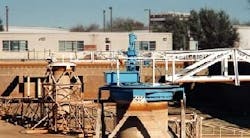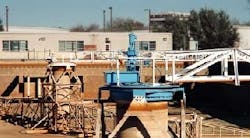Fully Grease-Lubricated Clarifier Drives Offer Advantages for Potable Water Plants
Most standard clarifier drives have either oil lubrication or some combination of oil and grease. In older drives, which have strip-liner-type main bearing races, the main gear and the main bearing are lubricated by a common oil bath, while primary and secondary reducers might contain oil or grease. In newer drives, most of which have a precision main bearing, the main bearing is sealed and runs in grease, while the main gear runs partially immersed in oil. Again, primary and secondary reducers might contain oil or grease.
In WesTech's totally grease-lubricated clarifier drive there are no oil-lubricated components. Both the main bearing and the main gear are lubricated by grease, as are primary and secondary reducers. The main bearing is sealed and the two principal grease reservoirs are thus kept separate. A tapered grease guide next to the main pinion passively redirects grease from the pinion back to the mesh of the pinion and the main gear so that it is not lost to its lubrication function. Condensate water drains away through a number of "weep" holes in the inner circumference of the main gear housing.
In a typical 60-foot-diameter clarifier, as little as 1/2 tablespoon of spilled oil would be enough to exceed the 5 ppb limit and cause oil contamination problems. Grease will not leak out of the drive, as oil will tend to do, both because of its own high viscosity and because of the tighter tolerances of the main bearing seals. A non-toxic, organic food-grade grease can be used in place of petroleum-based grease for additional safety.
Full grease lubrication eliminates oil changes and the necessity of condensate monitoring and draining. The only maintenance necessary is the routine periodic addition of grease with a grease gun. The entire lubrication regimen can be completed in a few minutes. Manual grease lubrication can be eliminated altogether with the installation of inexpensive, widely available electrical or gas-operated automatic grease lubricators.
Full grease lubrication increases clarifier drive life in three ways. First, grease, because of its high viscosity and surface tension (stickiness), tends to coat the components of the drive. This grease coating not only lubricates gears and bearings and other moving parts, but seals the coated parts against dirt and corrosive airborne moisture as well. The 24th edition of Machinery's Handbook (1988) contains this recommendation: "Anti-friction bearings are normally grease lubricated, both because grease is much easier than oil to retain in the housing over a long period and because it acts to some extent as a seal against the entry of dirt and other contaminants into the bearings."
Second, while oil and grease are both good lubricants, grease is an inherently superior lubricant to oil in slow-rotating machinery such as clarifier drives. In high-speed machinery, oil is not only a lubricant, but serves to dissipate heat as well. Slow-speed machines such as clarifier drives, which do not generate as much heat, require instead a lubricant with the high surface tension of grease to insure that lubricant is always present to prevent wear during surface contact between gear teeth, bearing balls and other power transmitting parts.
And third, but perhaps most important, full grease lubrication eliminates the accumulation of condensate, which is probably the most common and potentially the most destructive problem in all large gear housings, clarifier drives being no exception. If allowed to accumulate, condensate can displace lubricant and reach bearings and gears, corroding and damaging them and causing them to seize and fail. In cold weather, accumulated condensate can also freeze, impeding the operation of moving parts and damaging them through the heaving action of ice. Full grease lubrication prevents these problems by allowing condensate to drain away and preventing contact between condensate and the surfaces of corrodible metal parts.
Conclusion
Full grease lubrication has been used in clarifier drives for more than 13 years. It has been used in both industrial and municipal clarifier drives, in both water and wastewater treatment, and in a variety of different conditions and climates, with very good results. Superintendents, operators and maintenance people have been happy with it because it prevents water contamination, reduces maintenance, eliminates maintenance problems and decreases operational and maintenance costs.

